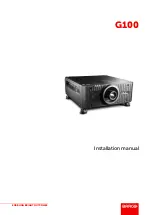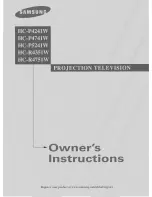
1-3 Precautions for Electrostatically Sensitive Devices (ESDs)
1. Some semiconductor (“solid state”) devices
are easily damaged by static electricity. Such
components are called Electrostatically
Sensitive Devices (ESDs); examples include
integrated circuits and some field-effect
transistors. The following techniques will
reduce the occurrence of component damage
caused by static electricity.
2. Immediately before handling any semicon
ductor components or assemblies, drain the
electrostatic charge from your body by
touching a known earth ground. Alternatively,
wear a discharging wrist-strap device. (Be
sure to remove it prior to applying power—
this is an electric shock precaution.)
3. After removing an ESD-equipped assembly,
place it on a conductive surface such as
aluminum foil to prevent accumulation of
electrostatic charge.
4. Do not use freon-propelled chemicals. These
can generate electrical charges that damage
ESDs.
5. Use only a grounded-tip soldering iron when
soldering or unsoldering ESDs.
6. Use only an anti-static solder removal device.
Many solder removal devices are not rated as
“anti-static”; these can accumulate sufficient
electrical charge to damage ESDs.
7. Do not remove a replacement ESD from its
protective package until you are ready to
install it. Most replacement ESDs are
packaged with leads that are electrically
shorted together by conductive foam,
aluminum foil or other conductive materials.
8. Immediately before removing the protective
material from the leads of a replacement ESD,
touch the protective material to the chassis or
circuit assembly into which the device will be
installed.
9. Minimize body motions when handling
unpackaged replacement ESDs. Motions such
as brushing clothes together, or lifting a foot
from a carpeted floor can generate enough
static electricity to damage an ESD.
Precautions
1-4
Samsung Electronics
Summary of Contents for PT5492X
Page 15: ...Samsung Electronics 4 9 Alignment and Adjustments 4 5 1 PT5492 4 5 Screen Jig ...
Page 19: ...Samsung Electronics 4 13 Alignment and Adjustments 4 7 Convergence Adjustment ...
Page 20: ...4 14 Samsung Electronics Alignment and Adjustments ...
Page 21: ...Samsung Electronics 4 15 Alignment and Adjustments ...
Page 22: ...4 16 Samsung Electronics Alignment and Adjustments ...
Page 23: ...Samsung Electronics 4 17 Alignment and Adjustments ...
Page 24: ...4 18 Samsung Electronics Alignment and Adjustments ...
Page 32: ...4 26 Samsung Electronics Alignment and Adjustments 4 9 7 MTS Module ...
Page 38: ...MEMO 5 4 ...
Page 45: ...8 4 MEMO ...
Page 53: ...10 7 CRT Schematic Diagrams Samsung Electronics 10 7 ...
Page 55: ...10 9 CONVERGENCE MDL 1 Schematic Diagrams Samsung Electronics 10 9 ...
Page 56: ...Schematic Diagrams 10 10 Samsung Electronics 10 10 CONVERGENCE MDL 2 ...
Page 58: ...Schematic Diagrams 10 12 Samsung Electronics 10 12 2D COMB Power Line Signal Line ...
Page 59: ...10 13 PIP Schematic Diagrams Samsung Electronics 10 13 ...
Page 60: ...Schematic Diagrams 10 14 Samsung Electronics 10 14 TERMINAL 1 ...
Page 61: ...Schematic Diagrams Samsung Electronics 10 15 10 15 TERMINAL 2 ...
Page 62: ...Schematic Diagrams 10 16 Samsung Electronics 10 16 IF V M MODULE ...
Page 63: ...10 17 CHROMA INTERLACE ONLY Schematic Diagrams Samsung Electronics 10 17 ...
Page 64: ......






































